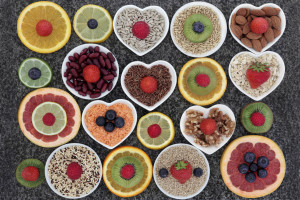AARP Eye Center
Want to Lose Weight? Add This One Thing to Your Diet
By Candy Sagon, March 11, 2015 07:00 AM

You want to get to a healthy weight, but let’s face it — diets can have a lot of complicated rules. Wouldn’t it be nice if there was just one simple thing to add to what you eat each day to help you shed some pounds?
University of Massachusetts Medical School researchers wondered the same thing, and now they think they have an answer: Eat more fiber.
In a yearlong study, published in the Annals of Internal Medicine, those who simply ate a lot more fiber did as well as those who followed a more complex diet.
The study involved 240 overweight adults (average age: 52) who were divided into two groups. One group was told to follow the American Heart Association’s (AHA’s) diet guidelines, which include some 13 rules such as “choose lean meats and poultry without skin, have six servings of grains per day, cut back on partially hydrogenated vegetable oils, eat 30 grams of fiber daily, reduce saturated fat to no more than 7 percent of total calories, prepare foods with little or no salt, and cut back on trans fat.”
The other group was just told to aim for 30 grams of fiber a day from a variety of foods, such as fruits, vegetables, beans and whole grains.
Get health and wellness discounts with your AARP Member Advantages. »
After a year, the heart association diet group had lost an average of about 6 pounds, while the fiber group had dropped an average 4.6 pounds. That’s a pretty small difference despite the large difference in the groups’ weight-loss strategies. Or, as health writer Olga Khazan of The Atlantic.com put it, “The people killing themselves to meet a raft of rules did roughly as well as the people who were simply eating more beans and apples.”
In addition, both groups by the end of 12 months had lower blood pressure, as well as decreased insulin resistance and better fasting insulin rates — important for warding off diabetes.
“These results suggest that focusing on a targeted fiber goal as a dietary intervention can be as clinically effective as the more intense AHA diet guidelines,” associate professor of medicine Yunsheng Ma, M.D., and his colleagues wrote.
Why was the “just eat more fiber” strategy successful? For one thing, it’s easier to follow a single rule than 13 of them. Plus, the fiber plan also stressed eating more of something, rather than being told to eat less, which made it easier to stick with, the researchers said in a statement.
Eating more fiber also seemed to improve other food choices. Coauthor Sherry Pagoto, a clinical psychologist and associate professor of medicine, said the study found that adding more fiber-rich foods to the diet “was accompanied by a host of other healthy dietary changes.
“For example, we saw that people in the high-fiber group decreased their sugar intake, sodium intake and their dietary-cholesterol intake,” she wrote in an email.
That may be because fiber is more satisfying and filling than simple carbs, she said. “You may feel fuller longer because it takes your body longer to digest it. It also helps to regulate blood sugar, which can prevent big swings in hunger.”
For those wanting to add more fiber to their diet, Pagoto suggests following the tips researchers gave the subjects in the study: Take a list of fiber-rich foods with you when you go grocery shopping. Add beans to soups, salads and pasta. Add nuts to yogurt, cereal and salad. If you like fruit, stick to the higher-fiber ones such as berries, pears and apples.
These foods have some of the highest grams of fiber per serving:
Legumes and nuts
- Split peas: 16 grams per cup
- Lentils: 15.6 grams per cup
- Black beans: 15 grams per cup
- Baked beans: 10 grams per cup
- Almonds, 1 ounce: 3.5 grams
Whole grains
- Spaghetti, whole wheat: 6.3 grams per cup
- Barley, cooked: 6 grams per cup
- Bran flakes, ¾ cup: 5.3 grams
- Oatmeal, instant: 4 grams per cup
Fruit
- Raspberries: 8 grams per cup
- Pear with skin: 5.5 grams
- Apple with skin: 4.4 grams
- Strawberries: 3 grams per cup
Vegetables
- Artichoke, 1 medium: 10.3 grams
- Green peas, cooked: 8.8 grams per cup
- Broccoli, cooked: 5 grams per cup
- Corn, cooked: 4 grams per cup
Photo: marilyna/iStock
Also of Interest
- New FDA Warning About Testosterone and Aging Men
- Do You Really Need That Colonoscopy?
- AARP Foundation Tax-Aide: Get free help preparing and filing your taxes
- Join AARP: savings, resources and news for your well-being
See the AARP home page for deals, savings tips, trivia and more.























































